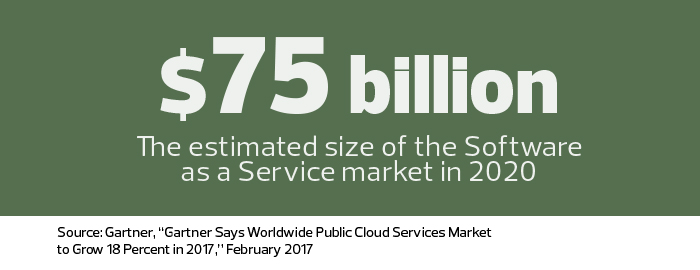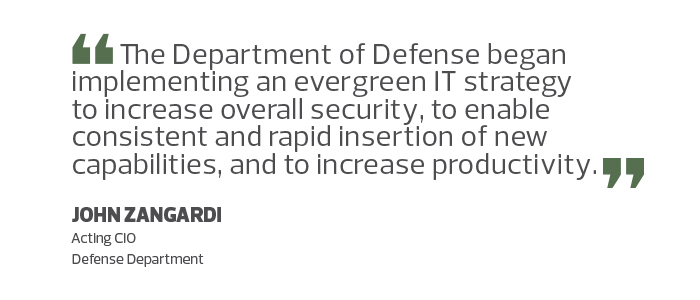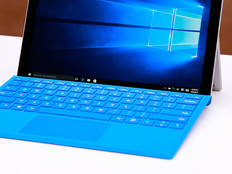The Tools the Government Uses to Keep Its IT Evergreen
For André Mendes, the CIO and CTO at the Broadcasting Board of Governors, the need for change was evident seven years ago. “We were like a mom-and-pop shop, running a lot of outdated, legacy hardware and software,” he says. “All our servers were hacked by a foreign entity.”
Older infrastructure is a problem that’s common across agency IT shops. More than 70 percent of federal IT spending goes toward legacy programs. But Mendes adopted an aggressive cloud-first strategy that relies on several commercial Software as a Service providers, as well as SaaS offerings from large government agencies that provide back-office functionality. BBG was the first major agency to adopt the full suite of Microsoft Office 365 Pro Plus, including email, SharePoint, federated identity and OneDrive. It also added fully virtualized computing and storage hardware from HP and NetApp, and purchased commercial software that transformed the organization from a technology laggard to one of the more advanced.
“Today our infrastructure is always up to date with the latest features and capabilities,” he says. “We pay others to take over the pain of administering and updating all that hardware and software with a level of competence, business continuity and security we could never match in house.”
SIGN UP: Get more news from the FedTech newsletter in your inbox every two weeks!
To get there, BBG, which oversees Voice of America, Radio Free Europe and other broadcasting channels, adopted a strategy commonly referred to as evergreen IT. In an era when legacy infrastructure can drag on constrained budgets and when the smallest vulnerability can lead to big problems, CIOs are looking to modernize their hardware and software to perpetually stay up to date, or evergreen. For Mendes, the evergreen approach paid off. The hacking has all but disappeared. The new technology has contributed to a 20 percent reduction in IT spending and led to more than $168 million in savings over five years.
From a staffing perspective, the agency’s IT teams can focus on strategic issues, especially projects that deliver the biggest benefits and those that differentiate the BBG from its competition.
Modular Services Drive the Evergreen IT Approach
The idea of evergreen IT appears to have developed about the time of the advent of the cloud-first philosophy, tech professionals say. Since then, the movement has gained followers as cloud adoption has spread.
But while the cloud plays a role in the evergreen strategy, IT leaders say the key driver is abandoning the albatrosses of day-to-day operations: legacy custom software, long two-year procurement cycles and massive hardware and software upgrades. Instead, agencies replace legacy infrastructure with modular services and components that continuously update their features and capabilities, a model exemplified by Windows 10 and Office 365. The result is hardware and software that are always up to date and offer new features, such as Microsoft’s Cortana assistant and new security definitions.

Evergreen IT can also entail virtualization of hardware, storage and network components as well as frequent hardware upgrades. With its automation and hardware abstraction, virtualization enables regular hardware improvements without the usual headaches.
“Nutanix started a trend with its one-click upgrade,” says Eric Burgener, research director for IDC’s storage practice. “In the past, you would have to shut down the system, upgrade firmware and software, test everything to make sure nothing broke, and put the storage and application back into production. Nutanix does a lot of the upgrading under the covers while it keeps everything running.”
Now major vendors such as NetApp and EMC offer the same automated upgrade capabilities.
Increase Productivity and Get Beyond Legacy IT
This approach was attractive to the government’s largest IT enterprise, the Defense Department.
“We began implementing an evergreen IT strategy to increase overall security, to enable consistent and rapid insertion of new capabilities, and to increase productivity,” says John Zangardi, the Pentagon’s acting CIO.
Already, DOD is undergoing a massive change to its IT operations as part of the Joint Information Environment initiative. As part of that plan, DOD will consolidate infrastructure, save money and reduce manpower costs. To achieve those goals, Zangardi says, “DOD is looking at a number of evergreen solutions.”

Pentagon leaders view evergreen as a solution to problems with legacy IT. Without proper maintenance, the DOD's IT foundation becomes less effective and requires more man-hours to support than most modern hardware and software. Moving to evergreen and leveraging commercial off-the-shelf solutions will help bring speed to the warfighter’s capabilities. This happens through agile, constantly updated and enhanced IT.
Through its Enterprise Collaboration and Productivity strategy, leaders want to deliver a set of shared capabilities using a commercially available SaaS solution. Zangardi also points to the department’s massive Windows 10 upgrade on 4 million devices as part of the Pentagon’s evergreen strategy.
The Hurdles to a Succesful Evergreen IT Strategy
But the transition to evergreen is not without its challenges.
Agencies need to be ready to adapt to a faster pace of change, says George Chambers, executive director of the office of IT and infrastructure operations at the Health and Human Services department, which is migrating to Windows 10 and Office 365. “The commercial subscription environments upgrade to the latest versions whether the customer is ready or not,” he says.
Burgener agrees. “Many organizations don’t trust the new evergreen upgrade model on Day One and stick with the older model for the first few upgrades until they’re comfortable,” he says.
In some cases, evergreen means IT leaders will need to revamp their existing processes. For example, DOD officials say they will rethink certification and accreditation and change the way they do business in IT service management. Evergreen will require significant cultural change and some retraining.
Migration can bring planning challenges as well. “Many of our mission-critical applications were dependent on older versions of software that were no longer supported by the vendor’s subscription cloud offerings,” Chambers says. “Mitigating these issues needs to be planned.”
Despite growing pains, Frank Hoeppel, deputy associate CIO for the Agriculture Department’s Client Technology Services, sees advantages in the agency’s ongoing move to Windows 10 and Office 365.
“The benefits of having the latest and greatest software, feature sets and security posture are critical for us,” Hoeppel says. “New features are often vital, particularly the opportunities in collaboration tools. Our move to Exchange in the cloud has delivered reliability, business continuity and stability we never could match before.”









